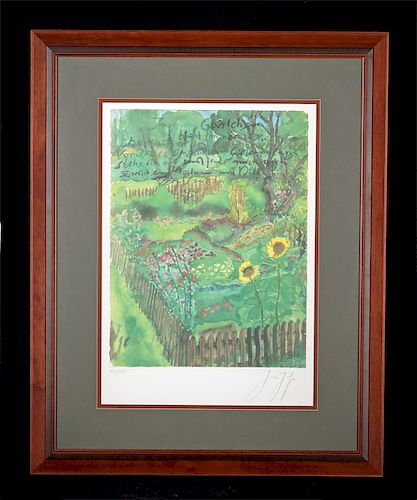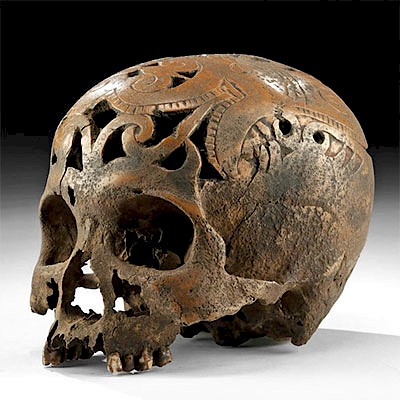Signed & Framed Gunther Grass Lithograph in Colors 1999
Lot 176
About Seller
Artemis Gallery
686 S Taylor Ave, Ste 106
Louisville, CO 80027
United States
Selling antiquities, ancient and ethnographic art online since 1993, Artemis Gallery specializes in Classical Antiquities (Egyptian, Greek, Roman, Near Eastern), Asian, Pre-Columbian, African / Tribal / Oceanographic art. Our extensive inventory includes pottery, stone, metal, wood, glass and textil...Read more
Categories
Estimate:
$800 - $1,200
Absentee vs Live bid
Two ways to bid:
- Leave a max absentee bid and the platform will bid on your behalf up to your maximum bid during the live auction.
- Bid live during the auction and your bids will be submitted real-time to the auctioneer.
Bid Increments
| Price | Bid Increment |
|---|---|
| $0 | $25 |
| $300 | $50 |
| $1,000 | $100 |
| $2,000 | $250 |
| $5,000 | $500 |
| $10,000 | $1,000 |
| $20,000 | $2,500 |
| $50,000 | $5,000 |
| $100,000 | $10,000 |
| $200,000 | $20,000 |
About Auction
By Artemis Gallery
Dec 12, 2019
Set Reminder
2019-12-12 10:00:00
2019-12-12 10:00:00
America/New_York
Bidsquare
Bidsquare : Holiday Sale - Antiquities / Ethnographic Art
https://www.bidsquare.com/auctions/artemis-gallery/holiday-sale---antiquities-ethnographic-art-4743
What to give this holiday season? You'll find plenty of options in our Dec. 12 auction that will cater to all tastes and budgets. Artemis Gallery info@artemisgallery.com
What to give this holiday season? You'll find plenty of options in our Dec. 12 auction that will cater to all tastes and budgets. Artemis Gallery info@artemisgallery.com
- Lot Description
**Holiday Shipping Deadlines**
USA Domestic: 12/14 for Standard; 12/23 for Express; International: 12/7 for Standard; 12/19 for Express
Gunter Grass (German, 1927-2015), "In ihrem Gartchen", lithograph in colors, 1999. Numbered 105/150 in pencil on lower left. Signed in pencil on lower right. A beautiful composition depicting a lush garden filled with sunflowers, pretty pink petaled clusters, and verdant trees, surrounded by a charming picket fence. On the upper third of the composition is the following text, "In ihrem Gartchen bluht immer was, uberschaubar, nur leicht verkrautet. Vor dieser umsaumten Seelenanlage stehe ich oft und finde mich auch: verpflanzt zwischen Malven un Dill" (In her garden flowers always something, manageable, only slightly weedy. I often stand in front of this fringed soul plant and find myself: transplanted between Malven and Dill). Size: 18.5" L x 14.125" W (47 cm x 35.9 cm); 32.25" L x 25.75" W (81.9 cm x 65.4 cm) framed
Gunter Grass was a 1999 Nobel Prize winner who was best known for his first novel entitled, "The Tin Drum" (1959). However, in addition to being a writer, Gunter was also an accomplished visual artist who worked in sculpture, drawing, printmaking, and graphic design. "With drawing, I am acutely aware of creating something on a sheet of paper,” Grass told the Paris Review in a 1992 interview. “It is a sensual act, which you cannot say about the act of writing. In fact, I often turn to drawing to recover from the writing."
According to an ArtNews article following his death, Gunter studied sculpture at the Kunstakademie Düsseldorf prior to becoming a writer. Eventually he also became a founding member of Group 47, a literary association whose mission was to "inform the German public about democracy in the wake of the Hitler era". Near the end of his life, he returned to visual art. In the Paris Review, Elizabeth Gaffney wrote, "Günter Grass has achieved a very rare thing in contemporary arts and letters, earning both critical respect and commercial success in every genre and artistic medium he has taken up."
The ArtNews article continues, "Apart from creating his own work, the novelist and artist was also an inspiration to other visual artists. Swiss-German artist Dieter Roth used pages from The Tin Drum in one of his 'Literaturewurst' sculptures, which he began creating in the 1960s. The main subject of the famed novel, the young drummer boy, was further referenced by Maurizio Cattelan (see Take a Peek at Art World Prankster Maurizio Cattelan’s Documentary) in his 2003 Untitled sculpture of a young boy playing a drum, which is in the Menil Collection and has been interpreted by some as a call to arms."
Provenance: private Long Island, New York, USA collection
All items legal to buy/sell under U.S. Statute covering cultural patrimony Code 2600, CHAPTER 14, and are guaranteed to be as described or your money back.
A Certificate of Authenticity will accompany all winning bids.
We ship worldwide and handle all shipping in-house for your convenience.
#147435Overall excellent. Custom framing. Has not been examined outside the frame. Wired for suspension. Accompanied by a postcard with an image of this piece and informative text written in German (see description for this text and a translation).Condition
- Shipping Info
-
All shipping is handled in-house for your convenience. Your invoice from Artemis Gallery will include shipping calculation instructions. If in doubt, please inquire BEFORE bidding for estimated shipping costs for individual items.
-
- Buyer's Premium



 EUR
EUR CAD
CAD AUD
AUD GBP
GBP MXN
MXN HKD
HKD CNY
CNY MYR
MYR SEK
SEK SGD
SGD CHF
CHF THB
THB
















